Royal Malaysian Navy
| Royal Malaysian Navy | |
|---|---|
| Tentera Laut DiRaja Malaysia | |
|
Crest of the Royal Malaysian Navy www.navy.mil.my | |
| Founded | 27 April 1934 |
| Country |
|
| Allegiance |
|
| Branch |
|
| Type | Navy |
| Role | Maritime security |
| Size |
Navy fleets:
|
| Garrison/HQ | Lumut, Perak |
| Nickname | TLDM |
| Motto | "Sedia Berkorban" (Ready to Sacrifice) |
| Engagements |
World War II Malayan Emergency Sarawak Communist Insurgency Indonesia–Malaysia confrontation Communist Insurgency War UNIMOG 2004 Indian Ocean earthquake 2006 East Timorese Crisis (OA) UNIFIL War on Terrorism (Operation Enduring Freedom – Horn of Africa, Operation Dawn 9: Gulf of Aden) Moro attacks on Sabah (2013 standoff) |
| Commanders | |
| Captain-in-Chief | Sultan Sharafuddin Idris Shah of Selangor |
| Chief of Navy | Admiral Abdul Aziz Jaafar |
| Insignia | |
| Commissioning Pennant |
|
| Naval Ensign |
 |
| Naval Ensign (1963–1968) |
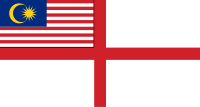 |
| Naval Ensign (1957–1963) |
 |
The Royal Malaysian Navy (RMN) (Malay: Tentera Laut DiRaja Malaysia; TLDM) is the naval arm of the Malaysian Armed Forces.
History
Straits Settlement Royal Naval Volunteer Reserve
The Royal Malaysian Navy can trace its roots to the formation of the Straits Settlement Royal Naval Volunteer Reserve (SSRNVR) in Singapore on 27 April 1934 by the British colonial government in Singapore. The SSRNVR was formed to assist the Royal Navy in the defence of Singapore, upon which the defence of the Malay Peninsula was based. Another reason behind its formation were political developments in Asia, particularly a Japan that was increasingly assertive in Asia. In 1938, the SSRNVR was expanded with a branch in Penang.
On 18 January 1935, the British Admiralty presented Singapore with an Acacia class sloop, HMS Laburnum, to serve as the Reserve's Headquarters and drill ship. It was berthed at the Telok Ayer Basin. HMS Laburnum was sunk in February 1942, prior to the capitulation of Singapore at the beginning of the Pacific Second World War.
With the outbreak of the Second World War in Europe, the SSRNVR increased the recruitment of mainly indigenous personnel into the force, to beef up local defences as Royal Navy resources were required in Europe.
Members of the SSRNVR were called up to active duty, and the force was augmented by members of the Royal Navy Malay Section. This formed the basis of the navy in Malaya, called the Malay Navy, manned by indigenous Malay personnel (similarly, the Malays were recruited into the fledgling Malay Regiment formed in 1936). The Malay Navy had a strength of 400 men who received their training at HMS Pelandok, the Royal Navy training establishment in Malaya. Recruitment was increased and in 1941 at the outbreak of the war in Asia, the Malay Navy had a strength of 1450 men.
Throughout the Second World War, the Malay Navy served with the Allied Forces in the Indian and Pacific theatre of operations. When the war ended with the Japanese Surrender in 1945, only 600 personnel of the Malay Navy reported for muster. Post war economic constraints saw the disbandment of the Malay Navy in 1947.
Post World War II – Formation of the Malayan Naval Force

The Malay Navy was reactivated on 24 December 1948 at the outbreak of the Malayan Emergency, the Communist-inspired insurgent war against the British Colonial government. The Malayan Naval Force regulation was officially gazetted on 4 March 1949 by the colonial authorities, and was based at an ex-Royal Air Force radio base station in Woodlands, Singapore. The base was initially called the 'MNF Barracks' but later renamed HMS Malaya. The Malayan RNVR was reconstituted as a joint force comprising the Singapore Division and the Federation Division, by an Ordinance passed in Singapore in 1952.
The main mission of the Malayan Naval Force (MNF) was coastal patrol to stop the communist terrorists from receiving supplies from the sea. In addition, the Force was tasked with guarding the approaches to Singapore and other ports.
The MNF was firstly equipped with a River class frigate, HMS Test, which was used as a training ship. By 1950, the MNF fleet had expanded to include ex-Japanese minelayer, HMS Laburnum, Landing Craft Tank (LST) HMS Pelandok ("Mousedeer"), motor fishing vessel HMS Panglima ("Marshal"), torpedo recovery vessel HMS Simbang and several seaward defence motor launches (SDML).
"Royal" Title
In August 1952, Queen Elizabeth II, bestowed the title "Royal Malayan Navy" to the Malayan Naval Force in recognition of the sterling service in action during the Malayan Emergency.
Independence
Malaya, soon after attaining independence on 31 August 1957, had successfully negotiated with the British Government and had the British Royal Malayan Navy transferred to the independent Federation of Malaya on 12 July 1958. With the hoisting of the Federation naval ensign – the White Ensign modified by the substitution of the Union Flag with the Federation flag in the canton – the RMN was thus made responsible for Malaya's maritime self-defence.
From then on it became Malayan owned and administered. The designation "Royal" in Royal Malayan Navy was now in reference to the Yang di-Pertuan Agong, who became the Supreme Commander of the Malaysian Armed Forces. All ships, facilities, and personnel serving in the Royal Malayan Navy were inherited by the Malayan government.
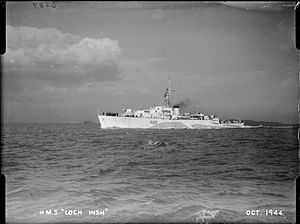
The new force shouldered the responsibility with only an operational and training base at HMMS Malaya and a small coastal fleet of one LCT, two Ham class minesweepers, one coastal minelayer, and seven MLs (the ex-RN 200th Patrol Squadron) on transfer from the Royal Navy. On 16 September 1963 the naval force was renamed the Royal Malaysian Navy, following the formation of Malaysia. The RMN was gradually strengthened after the formation of Malaysia. 18 Keris class patrol boats were ordered from Vosper, and these formed the mainstay of the navy for years to come. These 103 ft (31 m) boats were driven by Maybach diesels and capable of 27 knots (50 km/h). The Keris patrol boats were confined to coastal patrols and had short endurance. An offensive capability was acquired with the purchase of four Vosper Brave-class fast attack craft. The Perkasa class Fast Patrol Boats were built for the RMN by Vosper Thorneycroft in 1967, powered by three Rolls Royce Marine Proteus gas turbines as the main power plant with two diesel auxiliary engines for cruising and manoeuvring. These were armed with four 21-inch (53 cm) torpedoes, one Bofors 40 mm gun forward, and one 20 mm cannon aft. They had a maximum speed of 54 knots (100 km/h) and was driven by triple propellers.
The Royal Navy transferred the Loch class frigate HMS Loch Insh to the RMN in 1964 and renamed KD (Kapal di-Raja, "His Majesty's Ship") Hang Tuah. In 1965, during the Indonesian Confrontation, Hang Tuah took over guardship duties off Tawau from HMAS Yarra. The ship served as the flagship of the RMN until it was decommissioned in the 1970s and scrapped. The RMN also used some of the decommissioned ship as a part of navy monument. Visitor and tourist can visit and explore this nostalgic ship at Bandar Hilir, Melaka or at the Lumut Navy base.
Malaysianisation of the Navy
_underway_c1962.jpg)
Following the end of Indonesian Confrontation in 1966 Tunku Abdul Rahman and his colleagues decided to Malaysianise the top posts in the navy and air force. They initially offered these posts to two senior Malaysian army generals, who declined for two main reasons. First they felt that they were not professionally qualified and second because they did not want to jeopardise their own careers in the army.
Tunku and his colleagues then decided that they would select two officers, one from the navy and one from the air force, and appoint them chiefs of their respective services. They were fully aware of Rear Admiral Datuk K. Thanabalasingam's age but decided, nevertheless, to appoint him and take the risk. This exercise created history not only because Malaysians for the first time were appointed to these two top posts but also because of his age—he was 31 years old and a bachelor.
Under Thanabalasingam and with Tunku Abdul Rahman's foresight and will, they were responsible for initiating the gradual transformation of the navy from a coastal navy (brown water force) to an sea-going navy (green water navy).
1970s Onwards
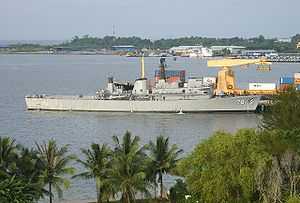
In 1977, the RMN acquired the frigate HMS Mermaid from the Royal Navy to replace the decommissioned Hang Tuah. The ship was also named KD Hang Tuah, but retained HMS Mermaid's pennant number of F76. Hang Tuah is a 2,300 standard ton light patrol frigate armed with twin 102 mm guns. Hang Tuah gradually reverted to a training role and currently continues in that role for the RMN. KD Rahmat (ex-HANG JEBAT) (F24) joined the RMN in 1972. The 2,300-ton ship was a one-off Yarrow light frigate design for the RMN. The ship was originally named KD Hang Jebat but renamed after initial propulsion problems during pre commissioning trials. It was the first Malaysian naval vessel equipped with a missile (Seacat) system. Rahmat was decommissioned in 2004.
The RMN purchased several types of missile boats in the 1970s and 80s. These were four Combattante II attack boats purchased from France and four Spica M from Sweden. Both classes were armed with the Exocet MM38 missiles. The RMN also acquired two 1,300-ton OPVs of Korean design. Sealift requirements were met by the purchases of several ex-United States Navy World War II-era LSTs.
KD Sri Langkawi (A1500), ex-USS Hunterdon County (LST-838), KD Sri Banggi (A1501),ex-USS Henry County (LST-834), and KD Rajah Jarom (A1502), ex-USS Sedgwick County (LST-1123), were replaced by KD Sri Indera Pura (A1505), the ex-Newport-class LST USS Spartanburg County (LST-1192). Additional sealift capability is provided by two 4,300-ton, 100-meter Multi-Role Support Ships, KD Sri Indera Sakti (A1503) and KD Mahawangsa (A1504).
Minehunting capabilities are provided by 4 Mahameru minehunters. These are Italian-built ships based on the Lerici, but displacing 610 tons. Hydrographic duties are handled by KD Perantau and KD Mutiara.
A Naval Air Wing was also founded with the purchase of ex-Royal Navy Westland Wasps.
Four ships of the RMN have been officially decommissioned and handed over to the Malaysian Maritime Enforcement Agency. The vessels are patrol boats KD Lembing and KD Sri Melaka, and offshore patrol vessels KD Marikh and KD Musytari. MMEA had received a total of 17 vessels from the RMN fleet to equip its enforcement operations. 6 of the vessels were transferred in August 2005 and 7 were handed over in January 2006.
Anti-piracy efforts
The Royal Malaysian Navy has been patrolling the Gulf of Aden to thwart piracy since 2009.[2] In January 2011 the navy foiled a hijacking attempt against the Malaysian-flagged MT Bunga Laurel chemical tanker carrying lubricating oil and ethylene dichloride. The navy ship Bunga Mas 5 responded after receiving a distress signal from the ship. A Fennec attack helicopter was used to pin down the pirate mothership as commandos boarded the tanker. The commandos injured three pirates in the battle to re-take the ship. 23 sailors were rescued and seven Somali pirates were detained. According to a Friday, 11 February 2011 online breaking news update by CNN's Brad Lendon, the seven Somalis, including three boys under 15 years old, could face the death penalty if convicted on charges of firing on Malaysian armed forces- navy commandos- while attempting to hijack the ship. The seven was sentenced for four to seven years in prison by Malaysian High Court on 2 September 2013.[3] The ship was rescued 555 kilometres from the coast of Oman.[2][4][5]
Lahad Datu standoff
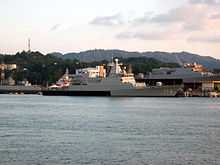
The 2013 Lahad Datu standoff was a military conflict standoff that started on 11 February 2013 and ended on 24 March 2013,[6] it arose after 235 militants, most of whom were armed,[7] arrived by boats in Lahad Datu, Sabah, Malaysia from Simunul island, Tawi-Tawi in the southern Philippines on 11 February 2013.[8][9][10] The group, calling themselves the "Royal Security Forces of the Sultanate of Sulu and North Borneo",[8] was sent by Jamalul Kiram III, one of the claimants to the throne of the Sultanate of Sulu. Kiram stated that their objective was to assert the unresolved territorial claim of the Philippines to eastern Sabah (the former North Borneo).[11] Malaysian security forces surrounded the village of Tanduo in Lahad Datu where the group had gathered and after several weeks of negotiations and broken deadlines for the intruders to withdraw, security forces moved in and routed the Sulu militants.
The Royal Malaysian Navy enforced a naval blockade to ensure that no more Sulu militants would be able to reach Sabah. The assets allocated for the blockade included KD Jebat, KD Perak, KD Todak, among many others. As well as enforced a naval special warfare unit for joint operations with army, air force and police commandos to track down and neutralise the militants.
Commanders of the RMN

_and_KD_Jebat(FFG29)_with_USS_George_Washington_(CVN_73).jpeg)

Chief of Navy
- Admiral Tan Sri Abdul Aziz Jaafar
Admiral Tan Sri Abdul Aziz Jaafar assumed his appointment as the Chief of Navy on 1 April 2008.
- Profiles
Admiral Datuk Abdul Aziz Jaafar was born in Sungai Udang, Malacca on 7 May 1956. He joined the service in 1974 and was then commissioned into His Majesty's service as a Sub-Lieutenan in 1977. He had his secondary education at the Sekolah Menengah Masjid Tanah and later at the Royal Military College, Sungai Besi.
Throughout his 31 years in service, Admiral Datul Abdul Abdul Aziz has held various appointments both at sea and ashore. He was the Chief of Staff to the Fleet Operations Commander in 2001. In July 2002 he assumed duty as Commander, Naval Region 2 in Labuan. In July 2005 he was appointed as Assistant Chief of Staff Human-Resources in RMN Headquarters. He was appointed as Fleet Operations Commander for 6 months on 27 January 2006 until 28 July 2006 before taking up his last job as the Assistant Chief of Staff Defence Operations and Training at the MAF Headquarters.
Admiral Datuk Abdul Aziz was a commissioning crew for 4 RMN ships namely KD PAUS in Hong Leong-Lurssen, Malaysia (1976), KD SRI INDERA SAKTI in Bremen, Germany (1980), KD KASTURI in Kiel (1984) and KD LAKSAMANA MUHAMMHAD AMIN in LA Spezia, Italy (1999). He has command of 3 RMN ships before, such as KD BAUNG in 1986, KD MUSYTARI an Offshore Patrol Vessel from 1994 to 1996 and KD LAKSAMANA MUHAMMAD AMIN from 1999–2001. He was the Senior Officer Afloat while commanding RMN Missile Corvette KD LAKSAMANA MUHAMMAD AMIN from 2000 to 2001.
Admiral Datuk Abdul Aziz has attended various professional and career courses locally and abroad. Among the courses were International Navigation Specialization Courses, United Kingdom in 1980, Malaysia Armed Forces Staff Course in 1991 and Naval Command Course at the Naval War College, United States in 1995. Whilst undergoing this course, he pursued his MA studies majoring in International Relations at the Salve Regina University graduating with distinction.
Admiral Datuk Abdul Aziz is married to Datin Sarah Tun Abdul Ghafar. He has a wide range of interests. He is a keen golfer and an avid reader. His favourite subjects are sports, international relations, leadership and management.
In recognition of his services, Admiral Datuk Abdul Aziz has been bestowed the Darjah Mulia Seri Melaka (DMSM) by the HE the Governor for the State of Malacca which carries the title of Datuk, the Malaysian Armed Forces award "Pahlawan Angkatan Tentera"(PAT), the National award " Johan Setia Mahkota"(JSM) and "Kesatria Mangku Negara"(KMN) and the State Award "Bintang Cemerlang Melaka"(BCM).
Ranks of The Royal Malaysian Navy
This is the list of ranks that is currently used in the Royal Malaysian Navy, from the highest rank to the lowest rank.
Flag Officers
| Rank | Admiral of the Fleet | Admiral | Vice Admiral | Rear Admiral | Commodore (lit. First Admiral) |
| Malay | Laksamana Armada | Laksamana | Laksamana Madya | Laksamana Muda | Laksamana Pertama |
The Sultan of Selangor, as Commodore-in-Chief of the RMN, holds the rank of Honorary Rear Admiral and as such wears a normal Rear Admiral's uniform.
Commissioned Officers
| Rank | Captain | Commander | Lieutenant Commander | Lieutenant | Sublieutenant | Junior Sub Lieutenant | Midshipman | Cadet |
| Malay | Kepten | Komander | Leftenan Komander | Leftenan | Leftenan Madya | Leftenan Muda | Kadet Kanan | Kadet |
Enlisted Rates
| Rank | Warrant Officer (1 and 2) | Chief Petty Officer | Petty Officer | Leading Rate | Able Seaman | Ordinary Seaman | Seaman | Recruit |
| Malay | Pegawai Waran (1 dan 2) | Bintara Kanan | Bintara Muda | Laskar Kanan | Laskar Kelas I | Laskar Kelas II | Laskar Muda | Perajurit Muda |
Squadrons of the Royal Malaysian Navy
_leads_the_Royal_Malaysian_Navy_frigate_KD_Lekir_(FF_26)_and_c.jpg)
- Squadron 21 Frigate
- Squadron 23 Frigate
- Squadron 22 Corvette
- Squadron 24 Corvette
- Squadron 26 Mine Counter Measure Vessel
- Squadron 31 MPCSS
- Squadron 32 SEALIFT
- Squadron 36 HYDRO
- Squadron 27 TRAINING VESSEL
- Squadron 1 FAC (M)
- Squadron 6 FPC (LABUAN)
- Squadron 13 PC (SANDAKAN)
- Squadron FAST TROOP VESSEL (FTV)
- Squadron DIVING TENDER
- Squadron TUG
Transferred to Malaysian Maritime Enforcement Agency
Musytari class offshore patrol vessels
- 160 KD Musytari
- 161 KD Marikh
Keris Class Patrol Craft
- ex-P 40 KD Lembing
- ex-P 3147 KD Sri Melaka
Bases
The RMN's Fleet HQ is called KD Malaya, in Lumut, Perak. Other bases are located at Tanjong Gelang, Kuantan, Pahang, which also serves as HQ Naval Region I and KD Sultan Ismail at Tanjung Pengelih, Johor, where the Recruit Training Centre is located. Bases are also located in Sandakan, Sabah. The principal submarine base is located at Teluk Sepanggar, Sabah, which also serves as HQ Naval Region II.
Another base is also being constructed on Pulau Langkawi, Kedah to provide the RMN with readier access into the Indian Ocean. Ready access into the Pacific Ocean is available via the existing base at Semporna, Sabah.
List of Naval Bases
Peninsular Malaysia
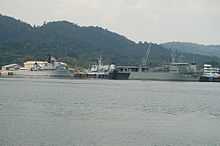
Lumut is known as The Home of Navy (Fleet HQ and location of Boustead Naval Shipyard)
- TLDM Tanjung Gelang, Pahang (HQ Naval Region I)
- TLDM Muar, Johor(HQ Naval Region II)
- TLDM Tanjung Gerak, Langkawi, Kedah (HQ Naval Region III)
- TLDM Tanjung Pengelih, Johor (Recruit Training Centre (PULAREK)) (KD Sultan Ismail)
- National Hydrographic Centre, Pulau Indah, Selangor (KD Sultan Abdul Aziz Shah)
East Malaysia
- TLDM Labuan, Federal Territory
- TLDM Sepanggar, Sabah (Submarine base)
- TLDM Sandakan, Sabah
- TLDM Semporna, Sabah
- TLDM Kuching, Sarawak
- TLDM Bintulu, Sarawak (construction confirmed)[13]
Offshore bases
Description

The Royal Malaysian Navy's five naval stations were originally built on outlying atolls, with the most developed Station Lima now expanded to a comfortably habitable naval station and also a popular diving spot in the region, in contrast with its harsh original conditions in 1983. On 21 June 1980 a claim plaque was erected on the island and three years later eighteen PASKAL men went ashore on May 1983 to build the first encampment while braving the elements. At the time, the only infrastructure available was a helipad for personnel transfer and the soldiers had to camp under the open skies on the bare reef. When the naval station proper was constructed six years later with the construction of a small living-cum-operations quarters, it was also decided that the enlarged island the atoll had become would also be developed as a tourist attraction so that the tourism potential of the island could be exploited. Thus by 1995, more buildings were added, including two air-conditioned accommodation blocks, an aircraft landing strip, two hangars, a radar station, an air traffic control tower, watchtowers and a jetty. The aviation facilities on the island allows the operation of C130 Hercules transport planes and CN-235 maritime patrol aircraft operated by the Royal Malaysian Air Force. These facilities made the island a proper island station code-named Station Lima. Patrols by navy soldiers in CB90 attack vessels and larger patrol boats such as the Kedah-class offshore patrol vessels are carried out around the island.The Royal Malaysian Air Force also operate frequently on the airstrip. Several anti-ship and anti-aircraft guns are placed on several areas on the island and the RMAF personnel operate a Starburst air defence system to prevent low-level air attacks there.
The rest of the stations were originally floating barge type habitat modules constructed on mainland Malaysia. Location selection and module positioning was done during high tide so that it could be more easily anchored during low tide and after found satisfactory, the modules were landed and filled in with cement and rocks to strengthen its anchorage. They are all also equipped with radar and ship docking facilities as well as water and power generation facilities. Soldiers are stationed on all stations. For further description
Offshore stations
- 1983 Station Lima (Swallow Reef)
- 1986 Station Uniform (Ardasier Reef)
- 1986 Station Mike (Mariveles Reef)
- 1999 Station Sierra (Erica Reef)
- 1999 Station Papa (Investigator Shoal)
Royal Malaysian Navy Fleet
Ships
All RMN ships carry the prefix KD (Malay: Kapal Di-Raja, literally Royal Ship), which is equivalent to "His Majesty's Ship" in English. The Training vessel Tunas Samudra however carries a KLD prefix (Kapal Layar Di-Raja) to mean His Majesty's Sailing Ship.
| Photo | Class | Origin | Type | Quantity | Ships | Notes |
|---|---|---|---|---|---|---|
| Submarine | ||||||
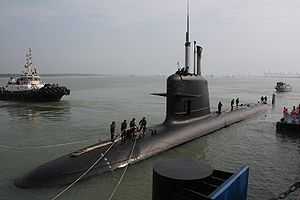 |
Perdana Menteri class | Submarine | 2 | KD Tunku Abdul Rahman KD Tun Abdul Razak |
Armament:
Mix for a total of 18 ×
| |
| Frigate | ||||||
 |
Gowind class | Stealth Frigate | (6)[14] | To be decided | On order/under construction[15][16] All 6 ships built by BNS locally[14] Armament:[17][18]
| |
_at_CARAT_2013.jpeg) |
Lekiu class | Frigate | 2 | KD Jebat KD Lekiu |
Armament:[20]
| |
| Corvette | ||||||
_is_underway_in_the_Strait_of_Malacca.jpg) |
Kasturi class | Corvette | 2 | KD Kasturi KD Lekir |
Armament:[21]
| |
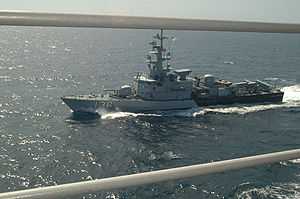 |
Laksamana class | Corvette | 4 | KD Laksamana Hang Nadim KD Laksamana Tun Abdul Jamil KD Laksamana Muhammad Amin KD Laksamana Tun Pusmah |
Armament:[22]
| |
| Patrol Vessel | ||||||
.jpg) |
Kedah class | Corvette/Offshore Patrol Vessel | 6 | KD Kedah KD Pahang KD Perak KD Terengganu KD Kelantan KD Selangor |
All ships are fitted for but not with anti-ship missile (SSM) and surface-to-air missile (SAM). Upgrade to missile-equipped corvette under planning.[23][24][25]4 of 6 ships were built locally by BNS Armament:[26]
| |
| Fast attack craft | ||||||
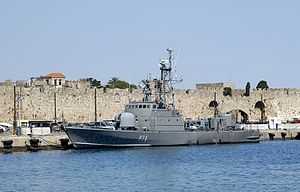 |
Perdana class | Missile boat | 4 | KD Perdana KD Serang KD Ganas KD Ganyang |
Armament:[27]
| |
| Handalan class | Missile boat | 4 | KD Handalan KD Perkasa KD Pendekar KD Gempita |
Armament:[28]
(To be replaced with Exocet MM40) | ||
| Jerung class | Gunboat | 6 | KD Jerung KD Todak KD Paus KD Yu KD Baung KD Pari |
Armament:[29]
| ||
 |
Kris Class | Gunboat | 2 | KD Sri Perlis KD Sri Johor |
Armament:[30]
| |
| Sri Tiga class | Fast Troop Vessel | 2 | KD Sri Tiga KD Sri Gaya |
|||
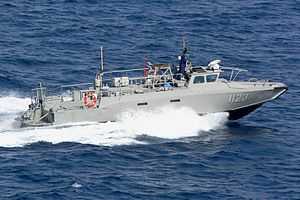 |
CB90-class | Fast Assault Craft | 17 | Tempur 11 Tempur 12 Tempur 13 Tempur 14 Tempur 15 Tempur 21 Tempur 22 Tempur 22 Tempur 23 Tempur 24 Tempur 32 Tempur 33 Tempur 34 Tempur 41 Tempur 42 Tempur 43 Tempur 44 |
||
| Multi-purpose Support Ship/Amphibious Warfare Ship | ||||||
 |
Sri Indera Sakti class | Multi-purpose Support Ship | 1 | KD Sri Indera Sakti | ||
_berthed_at_Lumut_Naval_Base.jpg) |
Mahawangsa class | Multi-purpose Support Ship | 1 | KD Mahawangsa | ||
| Auxiliary Vessels | ||||||
| MT Bunga Mas Lima | Auxiliary Vessels | 1 | Bunga Mas 5 | |||
| MT Bunga Mas Enam | Auxiliary Vessels | 1 | Bunga Mas 6 | |||
| Mega Bakti | Submarine rescue ship | 1 | MV Mega Bakti | Carried:
| ||
| Mines Countermeasures Vessel | ||||||
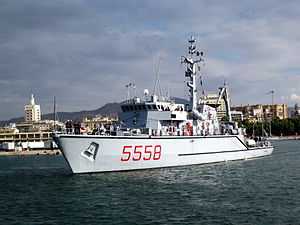 |
Mahamiru Class | Minesweeper | 4 | KD Mahamiru KD Jerai KD Ledang KD Kinabalu |
||
| Training Ship | ||||||
| Gagah Samudera class | Training Ship | 2 | KD Gagah Samudera KD Teguh Samudera |
|||
 |
Hang Tuah class | Training Ship | 1 | KD Hang Tuah | ||
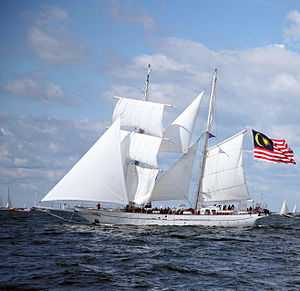 |
KLD Tunas Samudera | Training Ship | 1 | KLD Tunas Samudera | ||
| Hydrographic Survey Vessels | ||||||
| Perantau class | Hydro Ship | 1 | KD Perantau | Flooded on 20 November 2014 while undergoing refit at Boustead Naval Shipyard, Lumut, Perak.[31] Ship is expected to be repaired. | ||
| Mutiara class | Hydro Ship | 1 | KD Mutiara | |||
Royal Malaysian Navy Aircraft
| Aircraft | Photo | Role | Versions | Inventory | Notes |
|---|---|---|---|---|---|
| Westland Lynx | _in_the_South_China_Sea_during_landing_qualifications_June_18%2C_2013%2C_as_part_130618-N-PD773-083.jpg) | Anti-submarine warfare | Super Lynx 300 | 6 | It is equipped with 2 torpedoes or 4 MBDA Sea Skua anti-ship missile and also use as OTHT. |
| Eurocopter Fennec |  | Surface surveillance | AS 555SN | 6 | Combat capable |
Procurement news
In the late 1980s, another renovation was taken by the Royal Malaysian Navy. Four Laksamana class corvettes were purchased from Italy. These compact ships were originally built for Iraq, but were not delivered due to international sanctions put in place against Iraq.
A prominent addition to the fleet were two Lekiu class frigates. Based on the YARROW F2000 design, the two 2,300-ton frigates are armed with Exocet MM40 II SSM and the Sea Wolf VLS point defence SAM system with accommodation of one Westland Super Lynx helicopter.
Complementing the two Lekiu frigates are two German-built Kasturi class corvettes which were delivered in the early 1980s. These vessels, together with two Mahamiru (Lerici) class minehunters, had been scheduled to receive the Service Life Extension Programme (SLEP).[32]
Second order of Lekiu Class frigates
The Malaysian Minister of Defence, Najib Razak, announced at the Farnborough Air Show that Malaysia would be buying 2 frigates from the United Kingdom.[33] The Evening Times published on 20 July 2006 reported that the Clyde shipyard has won a contract to help build two Lekiu class warships for Malaysia.[34][35] The two frigates will be completed at Labuan Shipyard and Engineering in Malaysia as a condition of the deal. The new frigates are said to be benefit from the latest UKType 45 (T45) destroyer technology transfer.[36] However RMN had denied the report and said the authorities had not decided where to assemble the frigates.[37] While the price of procurement and technical speculations are yet to be decided, Annual Report 2006 published by MoD anticipates the new frigates to have a larger displacement than the current Lekiu class and capable of area air defence.[38]
The two ships were to have been completed at Labuan Shipyard as a condition of the deal, but were cancelled in August 2009. In 2013 Malaysia announced the purchasing of six Second Generation Patrol Vessels, and the Lekiu class batch 2 is presumed to be cancelled.
Kedah Class New Generation Patrol Vessel
In 1996, Royal Malaysian Navy (RMN) planned to acquire a total of 27 New Generation Patrol Vessels (NGPV) to full fill its future requirement. The Germany Blohm + Voss MEKO 100 based design was selected and a contract of 6 NGPVs was signed in 2003. However due to management failure of the main contractor, PSC-Naval Dockyard Sdn Bhd (PSC-ND), progression was seriously delayed and led the programme into crisis. This may also affect the initial planned total number of NGPVs to be decreased. However under the intervention of the Malaysian Government, Boustead Naval Shipyard Sdn Bhd took over the PSC-ND, thus regaining momentum for the programme.
After a long wait of 18 months, the first two hulls, KD Kedah commissioned in June 2006 and KD Pahang commissioned in August 2006. As of July 2009, all six ships had been launched. Subsequently good progression of the programme has regained interest in the Malaysian decision makers to order the second batch of 6 NGPVs. Navy Chief Admiral Datuk Abdul Aziz bin Jaafar had recently unveiled that the navy is interested to have the second batch of NGPV ASW configured. The ASW configured NGPV is expected to be able to co-ordinate operations with the Scorpène submarines. Latest news states that the ships will be upgrade with missiles[39]
Scorpène submarines
Two Scorpène class submarines were ordered by the RMN on 5 June 2002 under a €1.04 billion (about RM4.78 billion) contract.[40] The two Scorpène submarines were built jointly by the French shipbuilder, DCNS, and its Spanish partner, Navantia. They are armed with Blackshark wire-guided torpedoes and Exocet SM-39 sub-launched anti-ship missiles.[41]
The submarine programme also included the redeployment of an Agosta class submarine retired from the French Navy, for the training of submarine crews. The training of 150 Malaysian sailors, mainly in Brest, France, represented an important aspect of the programme.
In 2006, the RMN had launched a nationwide competition to select the names for the first two Malaysian submarines. On 26 July, RMN announced these vessels will be named after historic Malaysians. The first hull will be named KD Tunku Abdul Rahman and the second hull KD Tun Razak. These vessels are classified as Perdana Menteri Class in service with RMN.[42] The first vessel, KD Tunku Abdul Rahman was launched on 24 October 2007 at the DCNS dockyard, Cherbourg, France[43]
On 3 September 2009,the first Scorpène submarine of Malaysia KD Tunku Abdul Rahman, arrived at a Port Klang naval base on peninsular Malaysia's west coast after a 54-day voyage from France. Another base is also being constructed on Pulau Langkawi, Kedah to provide the RMN with readier access into the Indian Ocean. Ready access into the Pacific Ocean is available via the existing base at Semporna, Sabah.
Defects and problems were found in the submarines such as the inability to submerge and faults in the coolant system of the first submarine, causing delays in the delivery of the second submarine.[44][45][46] In October 2012, the Malaysian Navy chief Tan Sri Abdul Aziz Jaafar said that the submarines "[were] in good condition and [...] operational[47]"
Maritime patrol aircraft
Currently, RMN has no fixed wing patrol aircraft and is dependent on the RMAF's fleet of four Beechcraft B200T maritime patrol aircraft to execute long-range patrols. This procurement will enable RMN to focus on operational maritime surveillance whilst the RMAF focuses on a strategic surveillance role, through the acquisition of Airborne Early Warning aircraft. However there is no budget allocated for this procurement until RMK 9.[48]
SLEP
THALES Naval Division has been selected as the contractor of the Service Life Extension Programme (SLEP) involve of the Kasturi Class corvettes[49] – KD Kasturi, KD Lekir and two Mahamiru (Lerici) class minehunters – KD Mahamiru, KD Ledang. The corvettes will receive radar and fire control upgrade while the minehunters will receive the new wide band sonar, 2022MkIII. The programme aim to extend the service life of these surface combatants by another 10 years.[38][50][51] The RMN Future Fleet programme is component of second batch of Lekiu class frigates, Scorpène class submarines, New Generation Patrol Vessels (NGPV), Multi-Purpose Support Ship (MPSS) and maritime patrol aircraft. The ultimate goal is to build a six vessels squadron of each class by year 2020.[52]
Multi-Purpose Support Ship
RMN has an outstanding requirement for a Multi-Purpose Support Ship (MPSS) to replace the KD Inderapura. The MPSS was originally slated to be included in the Ninth Malaysian Plan but was subsequently postponed due the financial crisis of 2008. However, with the fire and damage to the KD Inderapura in October 2009, the replacement programme is expected to be restarted.
Anti-submarine helicopter
Navy chief Admiral Datuk Abdul Aziz Jaafar unveiled an intention of the navy to acquire at least six ASW helicopters as a complement to the soon to be commissioned Scorpène submarines. The navy is looking forward to include the procurement into the RMK 10. However he also admitted that the plan is still at the preliminary discussion stage. Recent reports suggest the ASW helicopter procurement is likely to be included in RMK 11.[53]
Littoral Combat Ship/Stealth Frigates
Special Forces
The special forces of the RMN is known as PASKAL (Pasukan Khas Laut or Naval Special Warfare Forces). In peacetime, the unit is tasked with responding to maritime hijacking incidents as well as protecting Malaysia's numerous offshore oil and gas platforms. Its wartime roles include seaborne infiltration, sabotaging of enemy naval assets and installations, and the defence of RMN vessels and bases. This unit is analogous to the United States Navy SEALs.
On 15 April 2009, PASKAL was renamed KD Panglima Hitam (KD being the equivalent of HMS in the Royal Navy). The ceremony was held at the RMN HQ Lumut to honour PASKAL's courage and loyalty to the nation. Panglima Hitam was the name given to brave and loyal Malay warriors who served during the golden age of the Malay Rulers (Sultans and Rajas) of Perak, Selangor, Johor and Negeri Sembilan.
See also
| Wikimedia Commons has media related to Royal Malaysian Navy. |
External links
- Official website of the Royal Malaysian Navy
- Official website of the Malaysian Armed Forces
- Official website of the Malaysian Ministry of Defence
- Commanders of the RMN
- Fleet of the RMN
- Unofficial Website of the Royal Malaysian Navy – 1960s and 1970s – Rare pictures included
- The Tunku – as I knew him, The Star, 21 August 2007.
References
- ↑ "Malaysian Armed Forces". GlobalSecurity.org.
- ↑ 2.0 2.1 Malaysia navy foils ship hijack attempt, seizes pirates, BBC News, 22 January 2011
- ↑ name="7 Lanun Somalia Dipenjara (in Malay)">"7 Lanun Somalia Dipenjara (in Malay)". Sinar Harian. 2 September 2013. Retrieved 15 January 2014.
- ↑ Malaysian navy foils hijack attempt off Oman, by Alex Richardson, 22 January 2011
- ↑ Malaysia navy frees hijacked tanker, Al Jazeera, 21 January 2011
- ↑ Kronologi pencerobohon Lahad Datu (video) (in Malay). Astro Awani. 15 February 2014. Event occurs at 1:20. Retrieved 27 February 2014.
- ↑ "Philippines' Aquino calls for talks on Sabah". Agence France-Presse. Yahoo! News. 17 March 2013. Retrieved 17 March 2013.
- ↑ 8.0 8.1 "Heirs of Sultan of Sulu pursue Sabah claim on their own". Philippine Daily Inquirer. 16 February 2013. Retrieved 20 February 2013.
- ↑ Michael Ubac; Dona Z. Pazzibugan (3 March 2013). "No surrender, we stay". Philippine Daily Inquirer. Retrieved 3 March 2013.
- ↑ Jethro Mullen (15 February 2013). "Filipino group on Borneo claims to represent sultanate, Malaysia says". CNN. Retrieved 25 February 2013.
- ↑ Mike Frialde (23 February 2013). "Sultanate of Sulu wants Sabah returned to Phl". The Philippine Star. Retrieved 24 February 2013.
- ↑ "WikiMapia Map of Lumut, Perak".
- ↑ "Malaysia to establish marine corps, naval base close to James Shoal". IHS Jane's 360.
- ↑ 14.0 14.1 "Malaysian Ministry of Defence Confirms Construction of Gowind ships for LCS program". Navy Recognition.
- ↑ NurW. "DEFENSE STUDIES". Retrieved 24 December 2014.
- ↑ "LCS will begin operations in 2018, says Hishammuddin". The Borneo Post.
- ↑ "Royal Malaysian Navy future Gowind class Littoral Combat Ship update at LIMA 2013". YouTube. Retrieved 24 December 2014.
- ↑ "Malaysia’s SGPV-LCS Gowind Frigates". Defense Industry Daily. 23 September 2014. Retrieved 24 December 2014.
- ↑ "Letter of Award for NSM ships equipment with Malaysian Boustead Naval Shipyard Sdn Bhd". 9 April 2015.
- ↑ "Lekiu Class - Naval Technology". Retrieved 24 December 2014.
- ↑ "Kasturi Class Corvettes - Naval Technology". Retrieved 24 December 2014.
- ↑ "Laksamana Class Missile Corvette - Naval Technology". Retrieved 24 December 2014.
- ↑ "Spreading The Joy…". Malaysia Defence.
- ↑ "Peluru berpandu di kapal peronda TLDM". Utusan Malaysia.
- ↑ "Malaysia Outlines Plans for Weapon, Radar Upgrade to Kedah-class OPVs". 3 August 2013.
- ↑ "Kedah Class Offshore Patrol Vessels - Naval Technology". Retrieved 24 December 2014.
- ↑ "KD PERDANA (3501)". Retrieved 24 December 2014.
- ↑ "KD HANDALAN (3511)". Retrieved 24 December 2014.
- ↑ "KD JERONG (3505)". Retrieved 24 December 2014.
- ↑ "KD Sri Perlis: Still Going Strong". Retrieved 24 December 2014.
- ↑ "Malaysian Navy's KD Perantau vessel sinks during refurbishment". Naval Technology. 20 November 2014. Retrieved 20 November 2014.
- ↑ "Modernization of Malaysian Navy". 19 May 2014.
- ↑ "A The Star article. Broken as of 13-11-2007".
- ↑ "Evening Times Article. Broken as of 13-11-2007".
- ↑ "Shipyards win Malaysian contract". BBC News. 19 July 2006. Retrieved 4 January 2010.
- ↑ "New Straits Time Article. Broken as of 13-11-2007".
- ↑ "Navy: No decision on frigates".
- ↑ 38.0 38.1 "2006年国防部年度报告书之一:马来西亚采购6套FN-6 第2批护卫舰成本介于35亿令吉至50亿令吉".
- ↑ NurW. "DEFENSE STUDIES". Retrieved 24 December 2014.
- ↑ "UNDERSEA WARFARE AND THE RMN".
- ↑ "SIPRI Report : Transfer Persenjataan ke Malaysia 2012". 22 March 2013.
- ↑ "Penyambungand dan penamaan kapal selam pertama".
- ↑ "First Malaysian sub launched".
- ↑ http://www.defenseworld.net/go/defensenews.jsp?id=4164
- ↑ "Malaysian Scorpene Back on Track After Short Setback". Retrieved 24 December 2014.
- ↑ "Malaysia Needs More Submarines". 14 May 2013.
- ↑ Submarines are not defective – Navy chief, theborneopost.com, October 16, 2012.
- ↑ "Market brief for U.S. exhibitors at Asian Aerospace 2004, Singapore".
- ↑ "KD Lekir Successfully Modernised". 8 November 2014.
- ↑ "Malaysia Buying European on Air, Anti-Air, and Naval Fronts".
- ↑ "Royal Malaysia Navy selects Thales for MCMV".
- ↑ "Interview with Dato' Sri Najib Tun Razak on 25 April 2006".
- ↑ "ASW Helo Buy Delayed to RMK11". Malaysian Defence.
| ||||||||||||||||||||||||||||||||||||||||||||||||||||||||||||||||||||||||||||||||||||
| ||||||||||||||||||||||||
| ||||||||||||||

.svg.png)